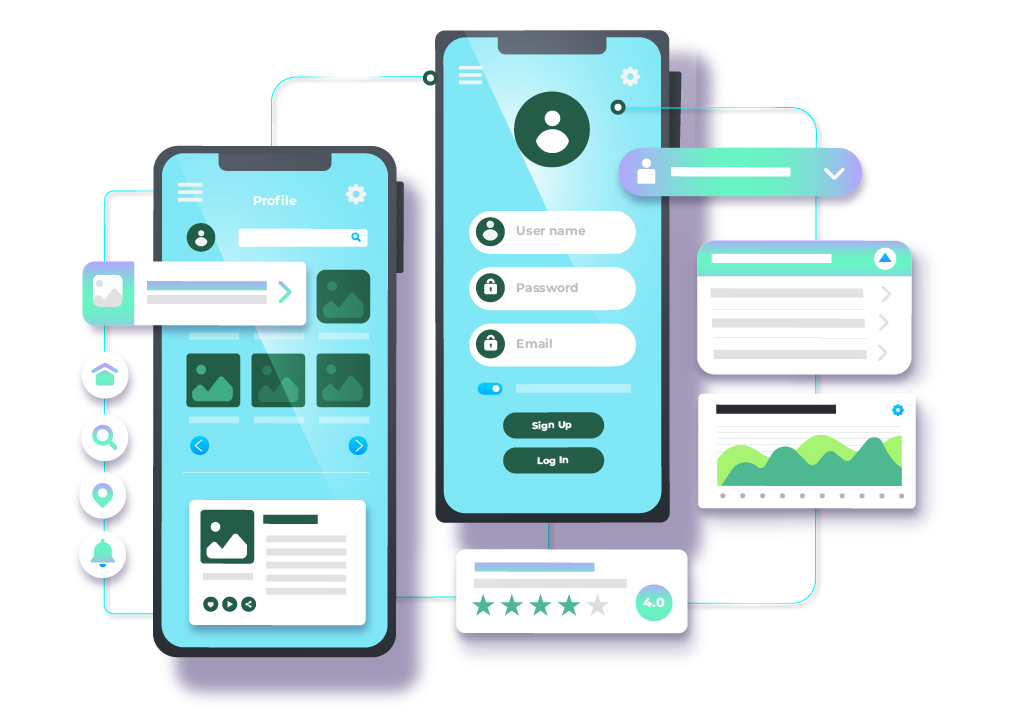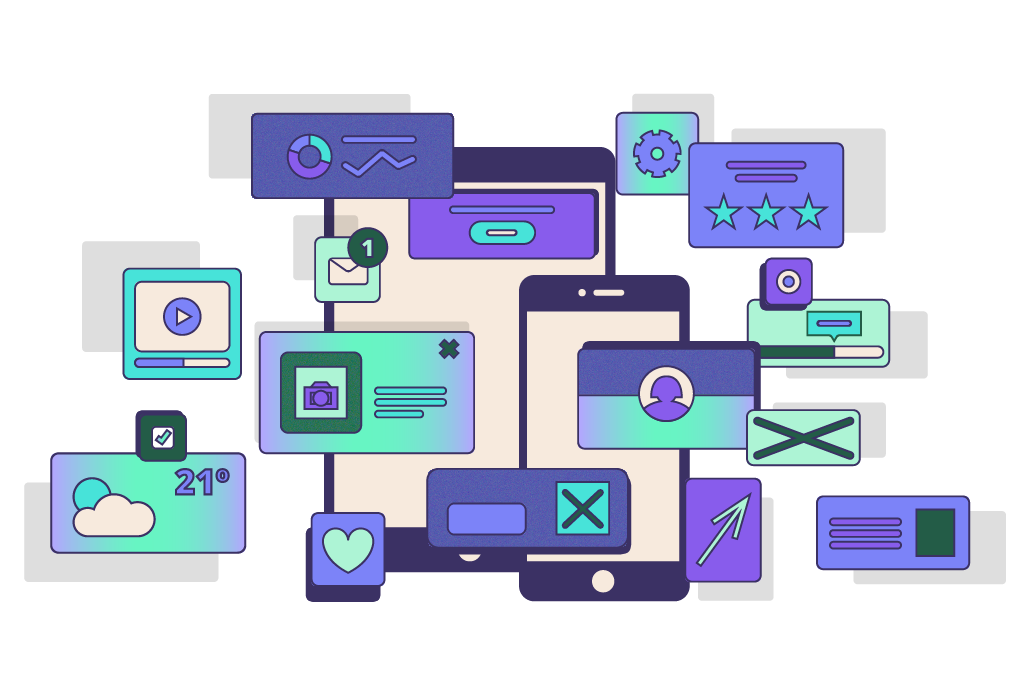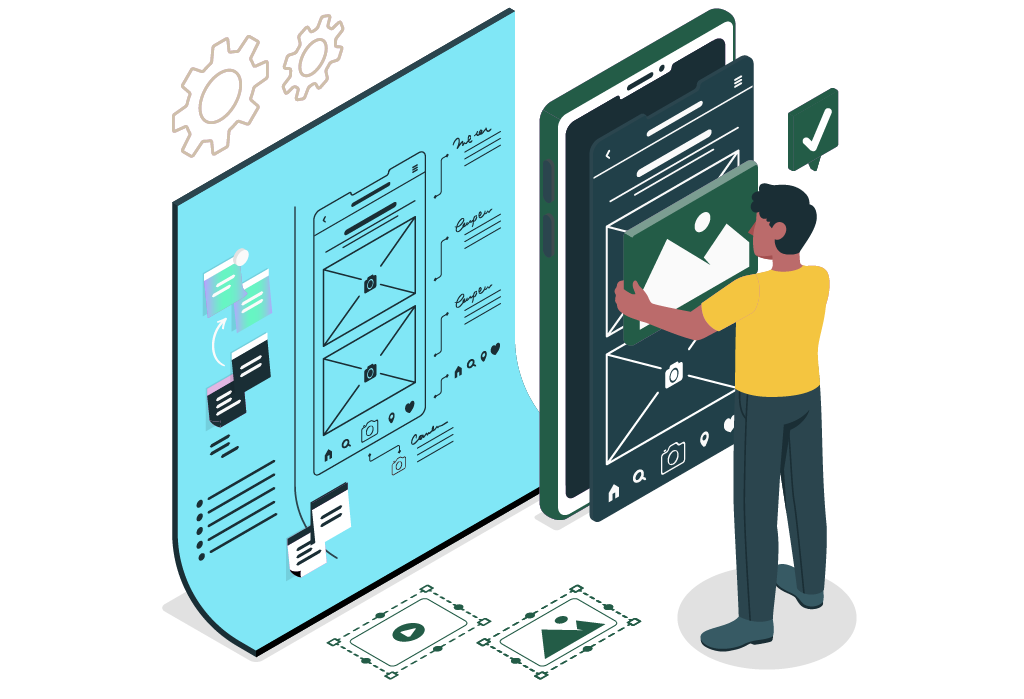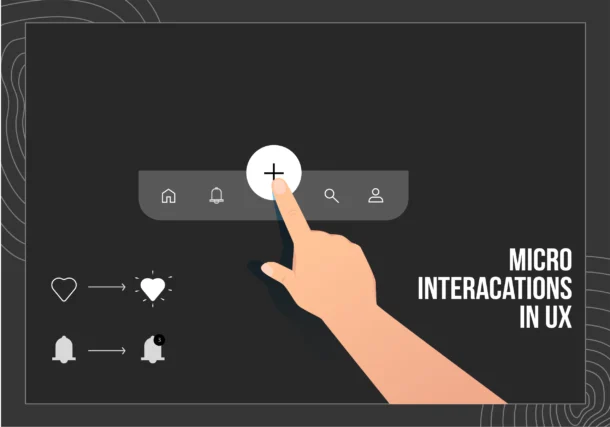Deep Dive into the Ocean of Mobile UX Design in Tech World
Over a million of the population uses mobile phones and it has become a mode of communication, work, transferring payments, e-commerce shopping, and so on. In the midst of all of these a major role is played by UX design that serves as a cornerstone ensuring that these functionalities are seamlessly integrated into the mobile experience and enhancing the usability and overall user experience.
Mobile UX design is a process of creating intuitive designs with efficient user experience while using a mobile application or device.  In today’s digitalization world, smartphones have become a universal extension of our daily lives, and the importance of delivering a seamless experience with better UX designs cannot be compromised. It consists of various holistic approaches that consider not only delivering aesthetic appeal or eye-catching websites but also quick loading time, functionality, and usability across various digital devices. Moreover, the major goal of UX design is to bridge the gap between users’ expectations and technologies, ensuring that interactions are not only enjoyable purposes but also flawless and rewarding.
In today’s digitalization world, smartphones have become a universal extension of our daily lives, and the importance of delivering a seamless experience with better UX designs cannot be compromised. It consists of various holistic approaches that consider not only delivering aesthetic appeal or eye-catching websites but also quick loading time, functionality, and usability across various digital devices. Moreover, the major goal of UX design is to bridge the gap between users’ expectations and technologies, ensuring that interactions are not only enjoyable purposes but also flawless and rewarding.
Additionally, Mobile UX design constantly strives to evolve in the sphere of advancement technology, shifts in user behavior, and emerging new design trends. UX designers are encouraged to design products that not only perform flawlessly but also deliver anticipating user needs, with well-crafted user-design solutions. Let’s go on the journey towards understanding the importance of having a good UX for mobile, tips on how to enhance UX design, what are the best Mobile app UX design, and looking into some success case studies. So let’s get started!
Unlocking the Crucial Elements Of Mobile UX Design for Seamless Functionality
Are you wondering why having a good UX (user experience) is essential? Or Why is it important for any brand or application to have a good UX (user experience)?
Let’s segment this, by providing a basic example. Imagine that you have a smartphone device that has a fingertip sensor to unlock your device. But whenever you try to unlock your device it fails to recognize your fingerprint sensation, and eventually, this leads to frustration and anger. As a result, you have to enter the pin to unlock your mobile device, which additionally takes time and effort. This is the case of bad or poor user experience or UX design.
Now, imagine the same situation with a different experience where you try to unlock your smartphone and it automatically detects your fingerprint and unlocks without any issues. This efficient and hassle-free experience demonstrates a UX design.
Having a good UX design experience is paramount as it directly impacts the user engagement, retention and overall satisfaction. A well-constructed mobile user experience ensures that a user can navigate around the app, locate what they need, and accomplish tasks efficiently without experiencing any technical glitches. Furthermore, a positive user experience cultivates a seed of trust, and loyalty, reassuring the user to come back again to the platform and recommend it to others! This not only enhances the visibility of your brand but elevates productivity, drives more engagement, increases conversion rate, and boosts revenue.
A well-constructed mobile user experience ensures that a user can navigate around the app, locate what they need, and accomplish tasks efficiently without experiencing any technical glitches. Furthermore, a positive user experience cultivates a seed of trust, and loyalty, reassuring the user to come back again to the platform and recommend it to others! This not only enhances the visibility of your brand but elevates productivity, drives more engagement, increases conversion rate, and boosts revenue.
Conversely, having a poor UX mobile can lead to frustration and a high bounce rate with poor feedback can harm your app’s reputation and hinder its growth. In the digital world, investing in good Mobile app UX design is all about understanding the user’s expectations, preferences, and behavior to cart pleasant experiences.
As technology continues to evolve and user expectations rise, prioritizing good mobile UX design becomes essential for businesses looking to stay competitive and meet the demands of today’s digital world. . Ultimately, a focus on good mobile UX design is key to achieving long-term success and sustainability in the ever-changing digital landscape.
Salting Down Some Experts Tips for Enhancing Mobile UX Design
When it comes to designing an application or mobile website, always prioritize its accessibility. The common psychological reason why people use mobile devices more than desktops is because it’s faster and more convenient to use. The convenience of this streamline is due to its UX design. A well-crafted UX mobile design ensures that a user can easily navigate and understand the application without any hiccups!
The basic tip for improvising mobile UX design is to prioritize planting the least cognitive loads for users, and apply a clear call to action that resonates with your brand or product. Try to organize the menu section and add icons with clear words, remember not all audiences are tech-savvy, so if your brand or product targets the boomer generation as well, consider cultivating easy icons to navigate from one screen to another. Furthermore, analyze that your app is responsive with less loading time and performs well across various screen sizes and devices.
Besides that, infuse simple content that is easy to read and ensure that all the digital devices can support the content. Additionally, limit the number of colors, fonts and sizes so that it should be visually engaging to the audiences. Avoid using dividers and try to declutter unnecessary content, and also make sure that links and other sections are clearly labeled in one segment. And also consider a smooth streamlined process for your user. Implement a basic tutorial exhibit where key functions and features are essential for providing users with a smooth and streamlined process.
Make sure that your app loads quickly, and saves data so that users don’t have to halt around.  Optimize touch-friendly interface that makes users interact with the app using gestures like swiping, tapping, etc. In addition, if you are seeking to enhance the user experience in mobile design try to minimize the inputs which involves designing the UX interface in such a way that offers maximum impact with minimum effort, and reduces the frustration with an ample amount of tapping. Also, try to practice continuity and consistency of contents between various screens like desktops or mobile, where they left off.
Optimize touch-friendly interface that makes users interact with the app using gestures like swiping, tapping, etc. In addition, if you are seeking to enhance the user experience in mobile design try to minimize the inputs which involves designing the UX interface in such a way that offers maximum impact with minimum effort, and reduces the frustration with an ample amount of tapping. Also, try to practice continuity and consistency of contents between various screens like desktops or mobile, where they left off.
On top of that make sure to gather feedback from real-time users through testing, analytics, and conducting surveys. Use this feedback to identify your customer’s pain points and the improvement niche, and ensure that the app remains aligned with the user’s expectations.
Always try to stay updated with the new trends that emerge in the growing market so that UX designers can incorporate new Mobile UX design templates, features, and techniques to stay ahead in the competitive industry and elevate the user experience. By implementing these tips and strategies, businesses can significantly improve their mobile UX and ultimately achieve more success in the industry.
Understanding Mobile Device Holding Pattern with its Impact on UX Design
Holding the gadget or mobile device can impact a lot of UX designing. Yes, it’s true! Wondering How? A user holds the devices in several ways according to their convenience, whether it’s one hand, two hands, or a combination of both. Generally, a user who carries a large smartphone device tends to hold it with two hands when typing or interacting with complex tasks. There are plethoras of discussion about how a user interacts or holds their mobile phone in many ways.
But for any UX designer, it is essential to understand the ergonomic preferences and usage scenarios. For example; a user may hold the device with one hand. So it is necessary to craft any mobile app UX design to switch between apps to apps smoothly. (Add one more Para)
Furthermore, understanding the user’s natural movements and gestures is also equally important to create seamless interaction that not only enhances user-friendly experiences but also satisfaction.
Tales of Real Time Cases of Companies Using UX Designs
In today’s ever-changing world businesses have started implementing UX design principles to enhance their product, drive more user engagement, and generate business growth. The transfer not only fundamentally understands that UX is more oriented towards user-centric attention but also a marketing strategy to stay ahead in this competitive era. So let’s read a few tales of famous mobile applications that used UX design to craft seamless applications and gained success in this tech world.
Instagram is a popular social networking app that implements a UX design for easy navigation through feeds, posting photos, and interacting with others. Its main focus is aligned towards displaying high-quality videos, and images in the feed. However, features like reels and stories provide interactive experiences for all the audiences and users, keeping them engaged and bringing them back to the app regularly.
Airbnb mobile application that offers a hassle-free booking experience for users around the world. The app has a search filter option and map-based interface that allow users to search for accommodation according to their preferences and needs.
Zomato, a top-notch food-delivering application, offers a seamless experience to both those who are diner-seeking and food enthusiasts to search for more food options. The application interface is clean, and visually appealing with creative features, allowing users to navigate menus, along with restaurants and cuisines according to their preferences. Zomato UX design also prioritizes highly generative images, overall making the user experience smooth and satisfying the needs.
Concluding our Topic with Pattem Digital Expertise in UX Design
In closing thoughts, Mobile UX design holds a paramount role in shaping the technology world. It is not only about creating an aesthetically eye-catching interface but also curating an application that seamlessly integrates functionality, and usability and enhances user satisfaction.
A good UX design is necessary in today’s tech-savvy realm to stand as a top-choice application in this competitive world. It directly impacts user engagement, and retention, and drives business growth and sustainability.
Real-life success stories of mobile applications like Instagram, Airbnb, and Zomato demonstrate how UX design can enhance their business and bring engagement.
In this journey of mobile UX design an excellent company that stands as the best UX Design Company is Pattem Digital. With its position as a prominent UX design firm, Pattem Digital brings forth a wealth of experience and proficiency in designing immersive mobile experiences that resonate with users, ultimately driving business growth and success in the dynamic digital world.





